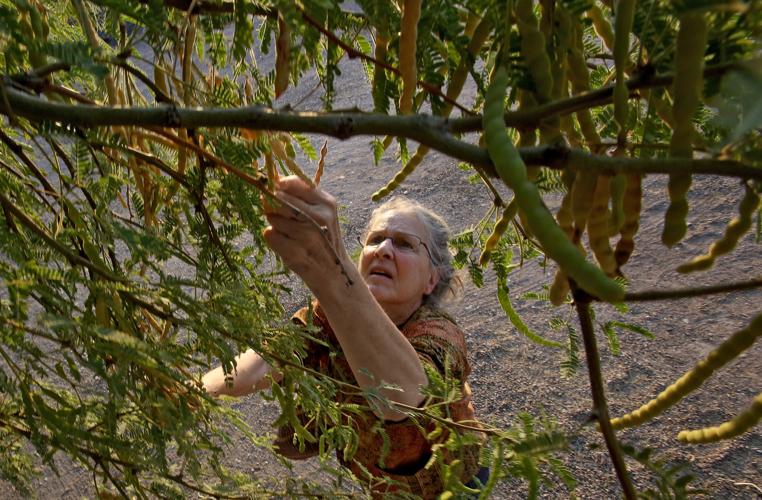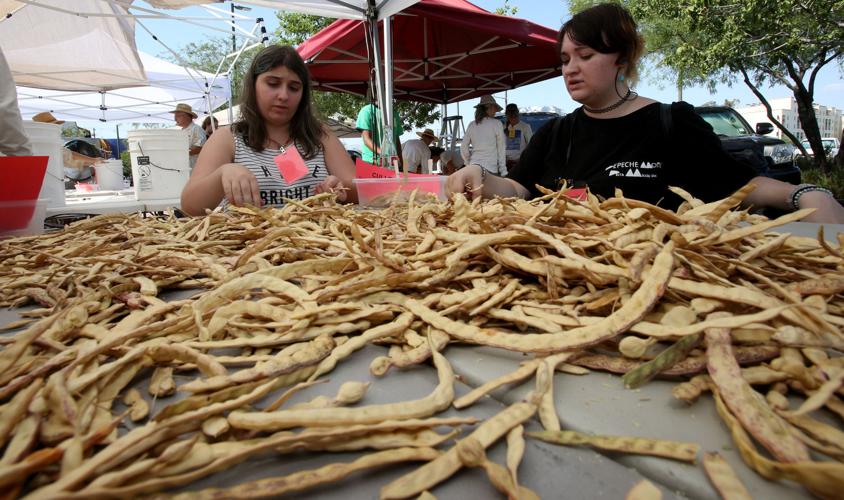In June, there are two kinds of people in Tucson: Those who look at our bright-blue skies with dry, squinty eyes and pray for rain from the billowing monsoon clouds in the distance, and an out-numbered few who ask that the rains stay away — a least for a little while longer.
The latter include mesquite-bean harvesters, who have spent days gathering the dry, yellowish pods that fall across Tucson’s neighborhoods, washes and parking lots.
Harvesters say their temporary aversion to rain is a matter of safety.
“When the rains do come, there is a huge spike in humidity,” said Barbara Rose with Bean Tree Farm north of Tucson.
“That’s when we worry about mesquite pods not being safe to eat.”
Moisture hydrates the pods, and there is an aflatoxin that is associated with moist pods, Rose said. Some of the effects of aflatoxin are sickness and even cancer, she said.
Harvested beans can be dried even further by putting them in an oven or left in the sun, then stored in dry, sealed containers until they are milled, Rose said.
That’s why many harvesters, like Rose, gather the beans during the hottest, driest time of year.
Not just any beans will do, because every tree has a distinctive taste characteristic.
Rose, who has been picking beans from the same velvet mesquite tree for 25 years, checks them for their sweet taste and pulls them before they fall to the ground.
Rose was recently picking pods for a mesquite-bean cooking demonstration at the Mesquite Milling and Fiesta with Desert Harvesters at the Santa Cruz River Farmers’ Market. The event, hosted by the Community Food Bank, took place Thursday at the Mercado San Agustín, 100 S. Avenida del Convento.
Harvesters took their clean, dry pods — those free of stones, leaves and other debris — for milling at $3 a gallon.
Mesquite flour is high in protein and can have a sweet, nutty, smoky taste. It’s also gluten-free and a good source of fiber, potassium, zinc, calcium and magnesium.
Harvester Barbara Padilla, who lives near Reid Park, has been bringing her beans from a velvet mesquite in her backyard for about five years.
“I like the idea of growing local food,” she said. “I like to know where my food comes from, it’s important.”
She also likes to make pancakes with the resulting flour. Padilla said she has an offer to sell some of her flour to a local coffee business, Exo Roast Co.
But she will also keep some of the mesquite flour for herself, Padilla said with a smile.
Lynn Townsend and Tim Kuhns, who also live in the Reid Park area, plan on making pie crusts, bread, smoothies and more from beans they harvested in Mesa, because their tree here was not ready for picking.
“I’m used to farming and growing my own food,” Townsend said.
“I like to make things from scratch because it tastes really good,” she added.
A hammermill is used to pulverize the pods and the hard seeds to dust, producing a light-brownish flour. The chaff is separated.
Once milled, a gallon of pods usually produces a pound of flour.
Linda Wood, the Desert Harvesters volunteer coordinator, estimated an average of 70 harvesters come to the milling and process an average of 500 gallons of flour.
While harvesters pay around $15 dollars for three to four pounds of flour, they can turn around and sell it for $15 a pound, she said.
And maybe now that the harvesting event is over, the mesquite harvesters can join the rest of Tucson in wishing for rain.







